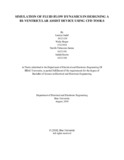| dc.contributor.advisor | Azad, A. K. M. Abdul Malek | |
| dc.contributor.author | Sadaf, Lamiya | |
| dc.contributor.author | Hoque, Walia | |
| dc.contributor.author | Zaima, Nazifa Tabassum | |
| dc.date.accessioned | 2019-09-19T06:37:38Z | |
| dc.date.available | 2019-09-19T06:37:38Z | |
| dc.date.copyright | 2019 | |
| dc.date.issued | 2019-08 | |
| dc.identifier.other | ID 19121158 | |
| dc.identifier.other | ID 15321014 | |
| dc.identifier.other | ID 16121101 | |
| dc.identifier.other | ID 16121144 | |
| dc.identifier.uri | http://hdl.handle.net/10361/12717 | |
| dc.description | This thesis is submitted in partial fulfillment of the requirements for the degree of Bachelor of Science in Electrical and Electronic Engineering, 2019. | en_US |
| dc.description | Cataloged from PDF version of thesis. | |
| dc.description | Includes bibliographical references (pages 91-96). | |
| dc.description.abstract | One of the main worldwide health worries now consists of cardiovascular diseases due to its fatality and the swiftly growing number of identified sufferers. Severe cases result in heart failures that require heart transplantations which are restricted by very limited number of available donor hearts. Henceforth, a Ventricular Assist Device (VAD) has been an advance development to deal with the heart scarcity problem by offering support to sustain patients while they are expecting donor hearts to become available, or even to use as a lifelong assistance if transplantation is not feasible. However, implementation of this device might result in damage to the blood cells; or in the worst-case scenario, mechanical failures can take place especially for those patients who suffered Bi-Ventricular heart failures. In consideration to the stated problems and to increase both the reliability and functioning of the device, the concept design of an innovative Bi-VAD with the help of computational fluid dynamics (CFD) is proposed in this thesis. The thesis aims to use CFD as the main designing tool to analyze flow and pump performance and interpret the hemodynamic and hydrodynamic risks associated with the preliminary stage of development. The thesis intends to find out the best design of the centrifugal pump that can be executed in experimental evaluation followed by human mock circulation in actual operating conditions.
The accomplished development of the heart pump and CFD analysis technique will have a hand in the heart pump construction by not only enhancing its performance but also reducing associated risks of complications in the design resulting in reduced lead time and cost of production. Further research is necessary that includes experimental implementation of the designs and henceforth animal and clinical trials before it is ready to support Bi-Ventricular failure patients giving them a light of hope apart from heart transplantation. | en_US |
| dc.description.statementofresponsibility | Lamiya Sadaf | |
| dc.description.statementofresponsibility | Walia Hoque | |
| dc.description.statementofresponsibility | Nazifa Tabassum Zaima | |
| dc.description.statementofresponsibility | Sadiah Karim | |
| dc.format.extent | 99 pages | |
| dc.language.iso | en | en_US |
| dc.publisher | Brac University | en_US |
| dc.rights | Brac University theses are protected by copyright. They may be viewed from this source for any purpose, but reproduction or distribution in any format is prohibited without written permission. | |
| dc.subject | VAD | en_US |
| dc.subject | Bi-VAD | en_US |
| dc.subject | CFD | en_US |
| dc.subject.lcsh | Fluid dynamics | |
| dc.subject.lcsh | Computational fluid dynamics | |
| dc.subject.lcsh | Heat--Transmission--Data processing | |
| dc.title | Simulation of fluid flow dynamics in designing a bi-ventricular assist device using CFD tools | en_US |
| dc.type | Thesis | en_US |
| dc.contributor.department | Department of Electrical and Electronic Engineering, Brac University | |
| dc.description.degree | B. Electrical and Electronic Engineering | |

